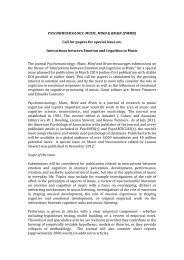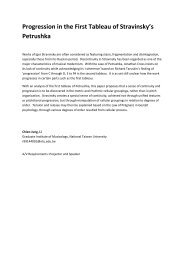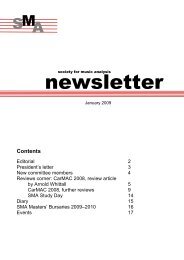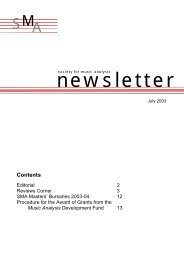Review - Society for Music Analysis
Review - Society for Music Analysis
Review - Society for Music Analysis
You also want an ePaper? Increase the reach of your titles
YUMPU automatically turns print PDFs into web optimized ePapers that Google loves.
The themes of timelessness and ineffability continued to provide an<br />
unconventional but fitting introduction to the final paper of this session in which Steve<br />
Tromans, himself an accomplished jazz pianist, moved easily between the<br />
confessional and more objective modes of presentation. Drawing on a wide range of<br />
sociological theoretical frameworks, Tromans sought to make sense of the temporal<br />
complexities inherent in the music-making process. Personal anecdotes and<br />
demonstrations at the piano served to <strong>for</strong>eground how the academic discourse<br />
generated by such a per<strong>for</strong>mative investigation can be communicated to music<br />
practitioners.<br />
Session 4 – New <strong>Music</strong> and New Approaches<br />
Chair: Dr Helen Thomas<br />
<br />
<br />
<br />
<br />
René Mogensen (Birmingham Conservatoire/Birmingham City University):<br />
‘Identifying Types of <strong>Music</strong>ian-Computer Interactivity in Score-Based Concert<br />
Works’<br />
Joseph Knowles (University of York): ‘The Implications of Set-Theory<br />
<strong>Analysis</strong> on the <strong>Music</strong> of Gesualdo’<br />
Jun Zubillaga-Pow (King’s College London): ‘Taking Chances: Schoenberg’s<br />
Fourth String Quartet and Aleatoric <strong>Analysis</strong>’<br />
Christopher Hayne (University of Surrey): ‘Structural Depth and Melodic<br />
Chains: Jonathan Harvey’s Madonna of Winter and Spring’<br />
The final session of TAGS 2013 brought together four very different<br />
perspectives on the music compositional process, by way of an extraordinarily rich<br />
selection of case-study works spanning six hundred years. René Mogensen strove<br />
to provide a typology of interactivity that was focused on musicians and electronic<br />
systems in live per<strong>for</strong>mance situations. Drawing from a variety of socioeconomic<br />
models, Mogensen first identified interactivity types that could be adequately<br />
described and analysed using the diagrammatic 'interaction interface', be<strong>for</strong>e<br />
investigating the data flow system of the musical work. Although the elaborate charts<br />
were occasionally difficult to absorb, this thorough investigation made <strong>for</strong> a rich<br />
presentation.<br />
Next, Joseph Knowles sought to examine the implications of set-theory<br />
analysis on Gesualdo's moving harmonies, in which modally conceived structures<br />
exist alongside passages of striking chromaticism, producing music that resists<br />
categorical fixity due to its inherent hybridity. Using Gesualdo's madrigal Mercè grido<br />
piangendo (Mercy, I cry, weeping) as an extended analytical example, Knowles was<br />
able to make sense of the composer's procedures through a pitch-class-set analysis<br />
that demonstrated an awareness of socio-historical contexts as well as a keen<br />
sensitivity to per<strong>for</strong>mative issues. Moreover, this paper was evidence enough that<br />
even the most complex, <strong>for</strong>bidding-to-the-uninitiated theoretical approach can be<br />
satisfyingly grasped if the analyst is able to present his ideas in a clear, stylish and<br />
musical way.<br />
Schoenberg's Fourth String Quartet <strong>for</strong>med the subject of the next paper, by<br />
Jun Zubillaga-Pow who opened his presentation with a video clip of Celine Dion's<br />
song 'Taking Chances'. Drawing from a variety of interdisciplinary theoretical<br />
frameworks, Zubillaga-Pow argued that Schoenberg's work merits an analytical<br />
approach rooted in what he called ‘historically analysed per<strong>for</strong>mance’ (HAP). He<br />
showed how the works’ modernist façade conceals the more traditional<br />
compositional practices that seem to find their precedence in Mozart's concertante<br />
works, especially when one relates syntactical organisation to expressive indications.







